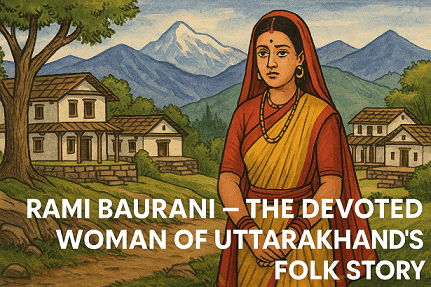By – Mohit Bangari
17 July 2025

Explore Himalaya With Me!!

In the heart of Uttarakhand’s Garhwal region, there lives a story that generations still sing and remember — the story of Rami Baurani. It’s not just a tale. It’s a reflection of the strength, patience, and unwavering faith that many pahadi women carry in their hearts.
This lok-katha (folk story) is still alive in the villages, especially in Chamoli district, where people narrate it during family gatherings and cultural evenings. The story is full of emotion, loyalty, and tradition.
Let’s walk through the tale of Rami and her journey of love, separation, and test.
The story of Rami is believed to have taken place in Ramani village, which lies in the Ghat block of Chamoli district. This Himalayan village, with its simple pahadi life, farming lands, and peaceful surroundings, sets the real-life background of the tale. Life here is tough due to terrain, but people are deeply rooted in their values and culture — just like Rami was.
The name “Baurani” is the local version of “Bahurani”, which means daughter-in-law in Hindi. In Garhwali, people lovingly call her Rami Baurani — not just a woman, but a symbol of devotion.
Rami was married to Beeru, a young man from a respected Rawat family. Soon after their marriage, Beeru was called to fight in Emperor Humayun’s army — a common practice in those times when Garhwal soldiers were recruited.
Beeru left, promising to return soon. But time passed — 1 year, 2 years, and then 12 long years — and there was no news of him. Many believed he might have died in the war. But Rami never gave up.
She stayed back with her old mother-in-law in the village. Every single day, she woke up before dawn. She worked in the fields, took care of cattle, cooked meals, and managed all the household work — just like any pahadi woman. But deep inside, she waited for her husband to return. Her love never changed.
After 12 years, Beeru finally came back. But he didn’t enter the village as himself. He came dressed as a jogi (a wandering sage). He wanted to test whether Rami had remained loyal or not.
He visited his own home and asked Rami for food. Rami, not recognising him, respectfully refused to serve food in her husband’s thali to a stranger. She also warned the jogi to leave, saying she is a loyal woman and will not entertain any man in her husband’s absence.
The jogi even tried to mislead her by saying, “Your husband died long ago, why are you still waiting for him?”
Rami boldly answered, “I don’t believe you. My heart knows he is alive. I will wait till my last breath.”
Finally, seeing her unbreakable faith, the jogi revealed his real identity. He said, “Rami, I am your Beeru. I only came in this form to see your loyalty.”
Tears filled both their eyes. The story ends with their emotional reunion. But the real win here is Rami’s shuddh prem aur vishwas (pure love and faith), which stands above everything.
Rami’s story became a folk song that people still sing in Garhwal. In 1918, a famous Garhwali writer named Baldev Prasad Sharma ‘Deen’ wrote a powerful song about her. The song is called “Bata Godai”, and it is considered one of the earliest written versions of this folk story in poetic form.
The lyrics express Rami’s dard (pain) and sabr (patience). They describe how she refuses the jogi, how she talks to her mother-in-law, and how strong her love is even after 12 years of waiting.
This song is still sung in villages of Uttarakhand. Many local artists have recorded their own versions of it in Garhwali folk music albums. In cultural events, women sometimes sing this song as a tribute to all the women who silently sacrifice and wait in the mountains.
If you ever visit a traditional function or mehfil in Chamoli or Rudraprayag, there’s a good chance someone will sing “Rami Baurani” with a dholak and harmonium in the background.
बाटा गोड़ाई क्या तेरो नौ छ,
बोल बौराणी कख तेरु गौं छ.
बटोई जोगी न पूछ मैकु,
केकु पूछ्दी क्या चैंदु त्वैकू.
…
बौराणी गाली नी देणि भौत,
कख रैंद गौं को सयाणो रौत.
जोगीन गौं मा अलेक लाई,
भूको छौं भोजन दे वा माई.
These lines express Rami’s defiance—she refuses the jogi’s insults and her refusal to serve him in her husband’s meal.
“Bata Godai kya teru nau chh?
Bol Baurani, kakh teru gaon chh?”
“Jogi, who are you now?
Tell me, daughter-in-law, where is your village?”
“Batoi jogi na pooch maiku,
keku puchdi kya chaindu tvaiku?”
“Dear jogi, don’t ask me this,
Why do you question me about him?”
“Baurani gaali ne deni bhaut,
kakh raind gao ko sayano raut.”
“The daughter-in-law won’t give curses,
How can a clever man from the village speak so?”
“Jogein gaun ma aalek lai,
bhuko chhoon bhojan deva mai.”
“This jogi came to the village,
Mother, I am hungry—please give him food.”
Even in today’s fast world, the story of Rami Baurani teaches us something deep.
It shows the strength of pahadi women.
It tells us about the value of loyalty, even when no one is watching.
And it reminds us that stories from villages carry more truth than big tales from books.
For locals, Rami is not just a character from a story. She is an ideal daughter-in-law, a symbol of Garhwali pride, and a reminder of the cultural depth of Uttarakhand.
The folk story of Rami Baurani is not just a love story. It’s a story of belief, sacrifice, and the silent power of a woman who never gave up. From the remote lanes of Ramani village to the lips of Garhwali folk singers, her tale continues to live.
We must preserve such stories. Because in them, we find the true soul of the Himalayas — pure, strong, and deeply emotional.
You can also explore more on Himalayan treks like Darma Valley, Adi Kailash, and others on my website mohitbangari.com, where I share full guides, routes, permit tips and cultural info.
By – Mohit Bangari
17 July 2025
Do you know about Ramman festival of Salud-Dungra village? It’s one of the intangible world cultural heritage of India in UNESCO. You can read a detailed article on this topic here.


Explore Himalaya With Me!!